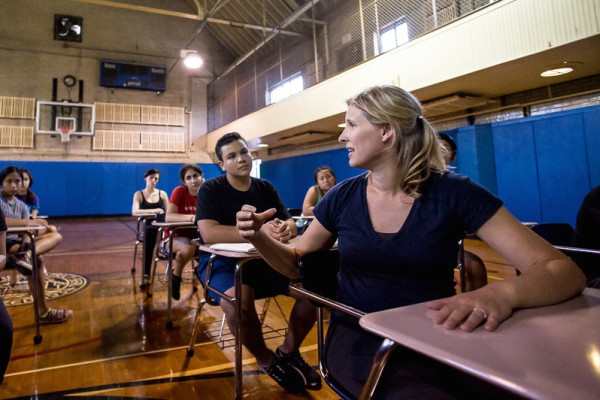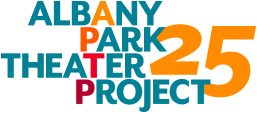I met David Feiner, artistic director of Albany Park Theater Project, in the fall of 2013 after he wrote to Third Rail Projects about his experience at our show Then She Fell and inquired about meeting to chat about sharing this format with the APTP youth ensemble. Working with teenagers is not exactly in my comfort zone, but faced with David’s enthusiasm and excitement, I found myself just saying “Well, how about we just come out to Chicago and teach a workshop with your company?”
"APTP has a 'yes' culture and it was unbelievable to be able to create in an environment where everyone is willing to try anything and open to experiment."
Artistic Director, Third Rail Projects
David invited me to come to Chicago to see the APTP youth ensemble perform God’s Work at the Goodman Theatre. Although I had done some research and was aware of the company’s reputation for making poignant and exceptional works, I was blown away by the performance – it was one of the most visceral responses I have had to a theater work in years. I realized right away that our companies have similar qualities and, although our formats may be different, our approaches to storytelling and devising work are very complementary.
When we were initially planning our week with the ensemble, we wondered if a teen, playing to an adult audience, could have the presence and status to hold a scene in an immersive format. After the first day of our workshop, we were amazed with the fearless, insightful, and thoughtful way that the APTP performers took on this challenge, as if they were just waiting for the opportunity to step off the stage and invite the audience into their world. The Third Rail Projects company members – Carlton Ward, Edward Rice, and Marissa Nielsen-Pincus – and I were surprised by the attention, commitment, and focus of these teenagers. APTP has a “yes” culture and it was unbelievable to be able to create in an environment where everyone is willing to try anything and open to experiment.
So our workshop plan went from “let’s introduce some immersive techniques to APTP” to “let’s make some immersive scenes, tie them together into a showing, invite a test audience, and see how it goes.”
And it went beautifully. So well in fact, that we decided to make a show together.

There was something magical that happened with these showings. We realized that the subject of high school is resonant with nearly every audience member who has struggled during those years that hopefully lead to a high school diploma and create the foundation for the future. It is common ground with universal themes that cross generations. In Learning Curve, audiences will explore what it means to be in a Chicago public high school today, while also having the space to remember and reflect on their own personal educational journeys, recognizing similarities and differences, successes and failures, shedding light on issues that persist over time and those which have evolved over time. They will share the everyday experiences of students through a performance that implicates, engages, and surrounds them.
"Third Rail’s work is about crafting the audience experience and taking care of the audience so that their journey is one of understanding a story by being placed inside of the story itself."
Artistic Director, Third Rail Projects
Immersive theater forms are very popular right now and take shape in all sorts of ways. Sometimes it seems like works are created in an immersive setting for the sake of jumping on the “immersive bandwagon” rather than because the form really serves the idea. Yet for some concepts this format is an amazing way to envelop an audience and create a potent multi-sensory experience.
You can tell a story about what it is like to be a high school student in a Chicago public school from a stage, looking out into the audience as they sit safely in their seats. Or you can tell the story to your audience by putting them in the shoes of a high school student within the walls of a Chicago public school. And who else should tell these stories but high school students themselves?

With this proximity and environment stimulation, scenes must be crafted to poetically and artistically depict situations through a theatrical lens, rather than straightforward realism. The way that APTP takes serious subject matter and depicts it poetically and symbolically is a quality that makes them particularly well-suited to immersive scenarios. They are able to embrace the approach that Third Rail takes to interfacing with audiences. Third Rail’s work is about crafting the audience experience and taking care of the audience so that their journey is one of understanding a story by being placed inside of the story itself.
As we continued with this second phase of development, we were delighted by the consistent generosity and community of the APTP ensemble. They are eager to develop their own characters, and if needed, jump in and work on content for each other. This fluidity gives their work a sense of authorship by the ensemble as a whole. They are performers with integrity and sincerity. In some ways, performing in an immersive setting and engaging with an audience is really about exceptional social skills. Being real and sincere, listening and responding to the audience, looking them in the eye – but not so much that it is uncomfortable, guiding them through the world in the way that serves the idea and makes them feel like they are making choices even if the world is actually curated and the path is pre-determined.
Learning Curve will bring many issues into the light about public education in Chicago and our nation, but it will also connect to audiences on a personal reflective level and explore issues that are a part of the coming of age experience of high school to everyone, whether you are in high school now or were a student decades ago.
This April, we look forward to inviting audiences back to “Eugene Field High School,” named after the Chicago Park District building that is home to APTP and generously letting us use its spaces to mock up Stage Two of the project. Their feedback and impressions will be invaluable for the final stage of development of the project, slated to premiere in the summer of 2016. Exactly two years after this journey began…

Rehearsal for the opening scene, staged in the gym, viewed by audience from the bleachers above; Immersive Workshop (2014); Photo by: Joe Mazza- Brave Lux Inc. http://bravelux.com
If you don’t have one of the 800 tickets to this spring’s 2015 sold-out, work-in-progress presentation of Learning Curve, add yourself to the APTP mailing list to be one of the first to know when tickets go on sale for the Summer 2016 world premiere of the full production.
Funding for the first two stages of Learning Curve was generously provided by the Michael D. and Jolynn Blair Family Foundation, the National Endowment for the Arts, the Pritzker Pucker Family Foundation, and the Theatre Seven Legacy Fund.
 Menu
Menu
